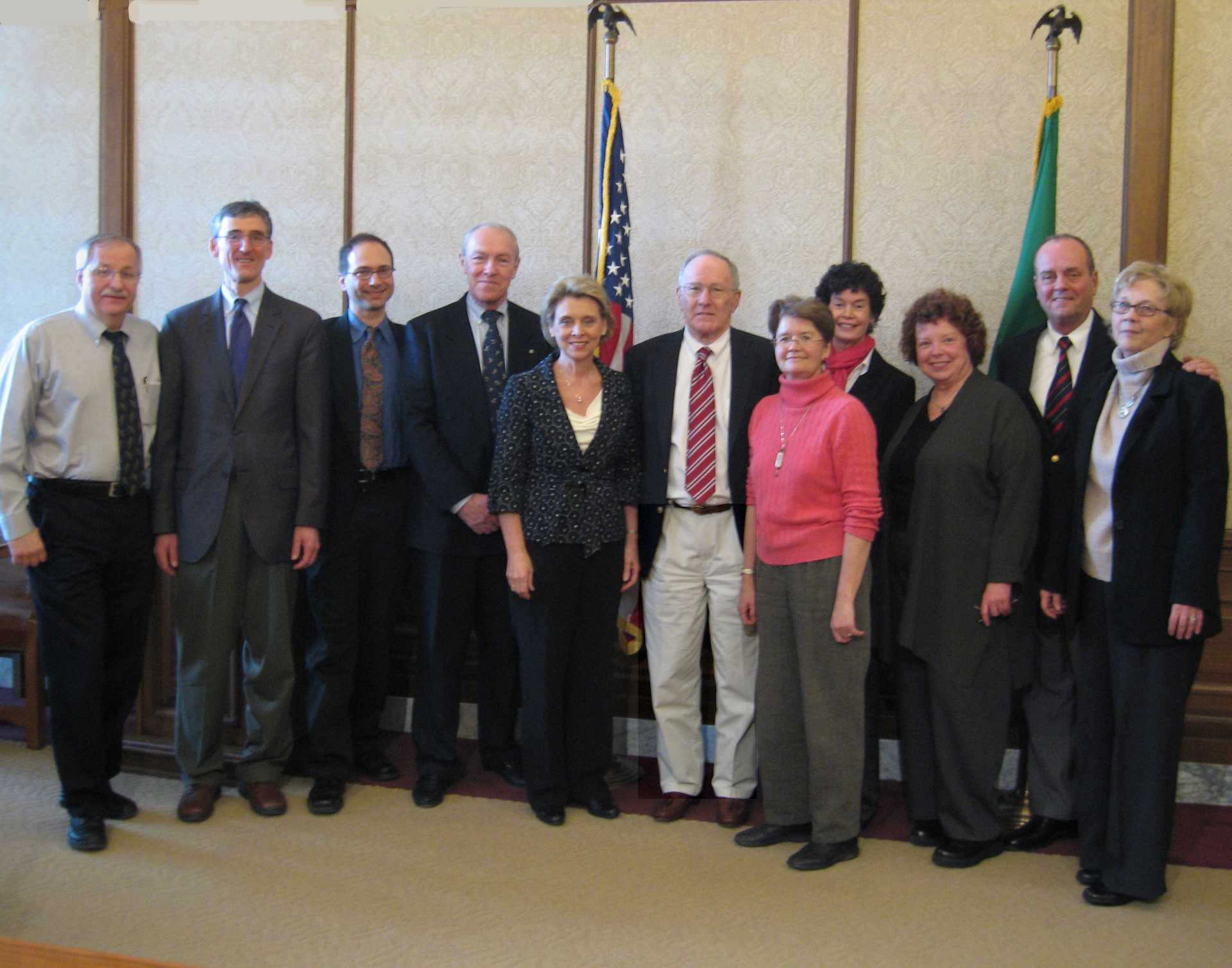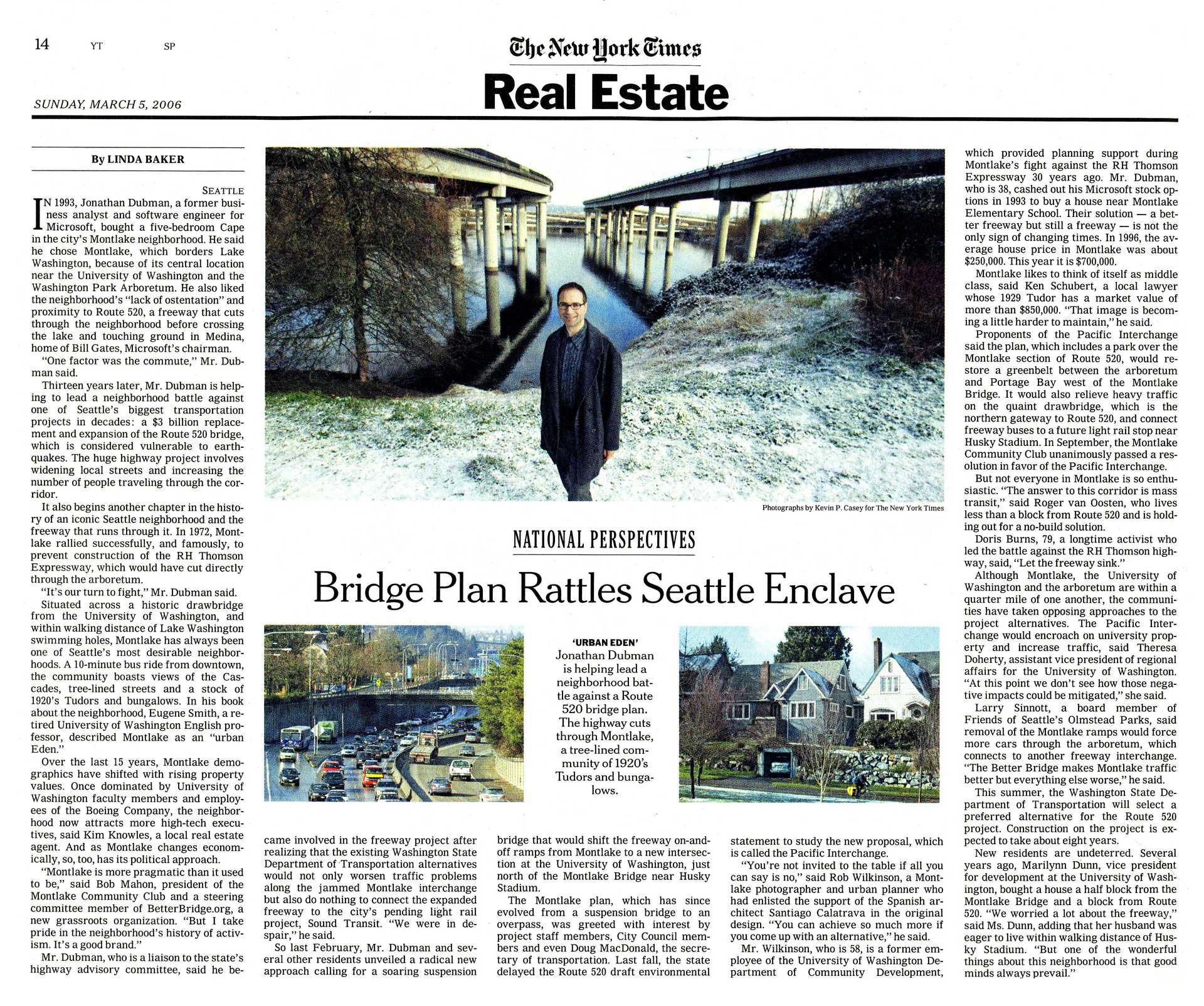Building a better bridge, and a parallel career

March 28, 2009 at the Governor’s Office, Olympia, Washington. Left to right: Frank Chopp (WA Speaker of the House), Robert Rosencrantz (then Montlake Community Club president), myself (Jonathan Dubman, past president), Maurice Cooper (Madison Park), Washington State Governor Christine Gregoire, Ted Lane (Roanoke Park), Paige Miller (Arboretum Foundation), Colleen McAleer (Laurelhurst), Fran Conley (Coordinator of Coalition for a Sustainable 520), Gary Stone (QCYC), Nancy Brainard (North Capitol Hill)
What’s all this about a bridge? What bridge?
The floating bridge carrying highway 520, packed to the gills with Microsoft commuters from Seattle like me, was at risk of sinking, in a state with a bad habit of sinking bridges. A replacement was desperately needed, but for years, for decades, there was a political stalemate on what that replacement should be.
By 2004, for complex reasons - but not good ones! - the state transportation department was veering toward a particularly big and costly mistake. They were gearing up to raise over $4 billion for a worst-case outcome: an oversized replacement that would cause avoidable and irreversible environmental harm, while simultaneously doing a lousy job as a transportation system in perpetutity.
This was a major public works project almost literally in my own backyard that was directly connected to the climate change issue I had first become aware of as a kid, while also connected to Microsoft and the region’s economic health. I read all their engineering studies, showed up to meetings, witnessed this, and saw a civic tragedy in the making. I had to get involved.
Call to action
I first felt called to action in 1997, when I left my full time engineering role at Microsoft and had some time to volunteer. I did not anticipate it would take 15 years to see that through during the planning phase of the SR 520 project. The corridor has been under major construction since 2011, and will be until the early 2030s. These things take time!
From the start, I knew that just collectively yelling NO! to a bad plan would only delay a bad outcome, while still failing to solve transportation problems. It would be a risky strategy if critical safety improvements were deferred. We needed a better plan, for a better bridge.

Above: New York Times, March 5, 2006. Photo shows me in front of the “ghost ramp” from the last time the state tried to build a highway through the same Arboretum.
A parallel career
And so, alongside my tech career, I developed a parallel career as a volunteer community organizer and representative, increasingly involved in city, regional and state politics. This side career never produced a dollar of income, though it did develop a heap of transferable skills.
By continually showing up, demonstrating my commitment, by being consistently well-informed and constructively critical, I managed to get myself appointed to the state’s Advisory Committee for this multi-billion-dollar megaproject, which meant now they had to listen to me.
I dove head first into the transportation and civil engineering fundamentals. I did all the homework. I read all the reports, and I found some unanswered questions and some flawed thinking. I discovered that I’d retained this uncanny ability to recall numbers I had glimpsed in a document when they later arose at a meeting, as I had done with astronomical quantities as a kid. I don’t even know where this comes from. But just as I was always correcting my teachers in grade school (totally endearing, I’m sure), as an adult, I could effortlessly catch executive committee members in real time when they made a mistake, which they did all the time because they were elected officials, not transportation engineers. We didn’t have direct power over the project, but that was satisfying. Neighbors started calling me Rain Man.
I was continuously thanked, and occasionally attacked by emergent political opponents, which we mostly laughed off. Some of them were people with a lot of power who were resentful and upset that we were getting so much traction. I was so effective, people tried to draft me to run for office and offered to raise money, I really just wanted to stay focused on this one problem. I was honored, but honestly, I realized I’m too honest for electoral politics. I realized I prefer writing code, where being provably correct is more highly valued. I also enjoy writing in English, apparently. And even public speaking, which I wouldn’t have guessed years ago.
Fear of public speaking affects as much as 75% of the population, an anxiety I lack. It helps to know your stuff. I’d done live radio and had lots of media exposure as a kid. In this role, I got a huge amount of experience with public speaking as well as asking groups of people (sometimes hundreds at a time) to contribute time and money, which we did, and they did. Together with some extremely talented and committed citizens who became great friends over the years, I worked directly with elected officials and their staff, agencies, planning and engineering consultants, chambers of commerce, other community and coalition leaders, advocacy organizations, stakeholders, the press and the public.The photo up top with the Governor wasn’t a meet-and-greet, it was part of an ongoing working relationship to solve this problem.
I issued a stream of co-authored opinion pieces for the mainstream press, gave countless radio and TV and news interviews and televised public testimony. I wrote letters, organized signature drives, and pored over every engineering document the state produced along the way, scouting for questions left unasked, problems unstated, and opportunities to improve the plan.
One thing led to another, and I ended up working directly with the highest levels of government in the state, all the way up the Governor herself and her staff, the state legislature and legislative committees, our US congressional delegation, the Mayors of all the affected cities, the King county council, the Seattle city council. As a citizen, I actually had an active hand in authoring real city and state legislation that affected the course of the project.
Early in my life, when I co-founded a software company as a kid, I got widespread media attention that I did not seek out, and this time, in my 30s, it happened again, for different reasons in a different place and completely different context. By 2006, our contributions, and the momentum we created, yielded a profile in the New York Times, where I am pictured standing in front of the abandoned “ramps to nowhere” after a rare burst of snow, a multi-layered symbol of standing up to protect an Arboretum from a highway, while our opponents were claiming the opposite. Locally, the news coverage was just constant. I was on local journalists’ speed dial (props to CR Douglas of Seattle Channel, and Mike Lindblom at the Seattle Times.)
Along the way I was continually recruited by my community to represent them. I co-founded more than one advocacy organization and participated in fundraising as well as hiring and managing many legal, engineering and PR consultants, which were often paid jobs created by unpaid volunteers.
Together with those I inspired, and the many who inspired me, we made a profound impact on - and by that, I mean, we completely changed - the schedule, the scope, and the shape of this multi-billion dollar infrastructure project. While we lost some big battles, we won many battles as well, and some of those victories are now embodied as award-winning infrastructure that will provide value for generations.
Beyond that, the experience I gained taught me innumerable lessons I’ll apply to my career and life. I have enough material to fill more than one book on this subject, but here, I just want to tell the essential arc of the story, whose timeline overlaps my software engineering career, and share a bit of what I learned and gained from the whole experience.
Left out of this version is a ton of great material, supporting media, colorful characters and vignettes, victories and losses en route, and some memorable dialogue it almost pains me to omit on the axis between hilarious and scandalous behind the scenes at the sausage factory where projects like this get made. If this chapter looks long to read, imagine having to attend 15 years of meetings!

Above: The integrated plan we dreamed up, crafted and promoted in 2005 for the University of Washington’s Lower Rainier Vista, Sound Transit’s Link Light Rail project and SR 520 bridge project at Pacific Street just north of the iconic Montlake Bridge, extending the historic Olmsted Plan dating back to 1909, linking the station to the central UW campus. Rendering by Peter Stoner, AIA.

Above: GGN’s multiple award winning Lower Rainier Vista plan at Sound Transit’s University of Washington Station, which opened in 2016, right at the signature entrance to the biggest university in the region. Look familiar? Even the artfully separated pedestrian and bicycle bridges were part of our 2005 plan, in the same configuration.